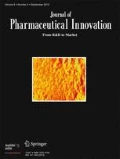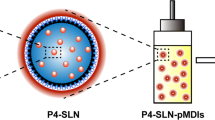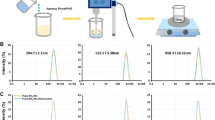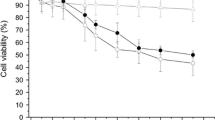Abstract
Solid lipid nanoparticles (SLN) have been intensively exploited as nanocarriers for pulmonary drug delivery. However, no consensus on the underlying mechanisms between particle sizes and cell uptake behaviors was attained owing to their unclear in vivo fate after inhalation, which hindered the further development of a novel nanoparticle delivery system. Recently, aggregation-caused quenching (ACQ) probes had been developed to monitor the integrity of nanocarriers. In this study, an ACQ probe, P4, was employed to clarify the effect of particle size on SLN cellular uptake. SLN (120, 240, and 480 nm in size), incubated with epithelium cells (A549) and macrophages (RAW 264.7), mainly localized in the cytoplasm in an integrated pattern, showing a positive correlation relationship between particle size and cellular intake. In conclusion, this study established a firm basis to understand the effect of particle size on cellular uptake of nanoparticle systems and promoted the development of novel pulmonary drug delivery systems.




Similar content being viewed by others
References
Riehemann K, et al. Nanomedicine—challenge and perspectives. Angew Chem Int Ed. 2009;48(5):872–97.
Docter D, et al. No king without a crown – impact of the nanomaterial-protein corona on nanobiomedicine. Nanomedicine. 2015;10(3):503–19.
Zhang Z, et al. Solid lipid nanoparticles loading candesartan cilexetil enhance oral bioavailability: in vitro characteristics and absorption mechanism in rats. Nanomed: Nanotechnol Biol Med. 2012;8(5):740–7.
Li H, et al. Enhancement of gastrointestinal absorption of quercetin by solid lipid nanoparticles. J Control Release. 2009;133(3):238–44.
Varshosaz J, et al. Biodistribution of amikacin solid lipid nanoparticles after pulmonary delivery. BioMed Res Int. 2013;2013:136859.
Hu X, et al. Bioimaging of nanoparticles: the crucial role of discriminating nanoparticles from free probes. Drug Discov Today. 2017;22(2):382–7.
Choi HS, et al. Rapid translocation of nanoparticles from the lung airspaces to the body. Nat Biotechnol. 2010;28(12):1300–3.
Kapralov AA, et al. Adsorption of surfactant lipids by single-walled carbon nanotubes in mouse lung upon pharyngeal aspiration. ACS Nano. 2012;6(5):4147–56.
Sadauskas E, et al. Biodistribution of gold nanoparticles in mouse lung following intratracheal instillation. Chem Cent J. 2009;3(1):16.
Braakhuis HM, et al. Particle size dependent deposition and pulmonary inflammation after short-term inhalation of silver nanoparticles. Part Fibre Toxicol. 2014;11(1):49.
Ryan GM, et al. Pulmonary administration of PEGylated polylysine dendrimers: absorption from the lung versus retention within the lung is highly size-dependent. Molecular Pharmaceutics. 2013;10(8):2986–95.
Rosière R, et al. New folate-grafted chitosan derivative to improve delivery of paclitaxel-loaded solid lipid nanoparticles for lung tumor therapy by inhalation. Mol Pharm. 2018;15(3):899–910.
Rivolta I, Lettiero B, Sesana S, Gasco P, Gasco MR, Masserini M, Miserocchi G. Cellular uptake of Coumarin-6 as a model drug loaded in solid lipid nanoparticles. J Physiol Pharmacol. 2011;62(1):45–53.
Ji P, et al. Naringenin-loaded solid lipid nanoparticles: preparation, controlled delivery, cellular uptake, and pulmonary pharmacokinetics. Drug Des Devel Ther. 2016;10:911–25.
He H, et al. The biological fate of orally administered mPEG-PDLLA polymeric micelles. J Control Release. 2020;327:725–36.
Xia F, et al. Size-dependent translocation of nanoemulsions via oral delivery. ACS Appl Mater Interfaces. 2017;9(26):21660–72.
Hu X, et al. Environment-responsive aza-BODIPY dyes quenching in water as potential probes to visualize the in vivo fate of lipid-based nanocarriers. Nanomed: Nanotechnol Biol Med. 2015;11(8):1939–48.
Sabatini R, et al. Molecularly isolated perylene diimides enable both strong exciton–photon coupling and high photoluminescence quantum yield. J Mater Chem C. 2019;7(10):2954–60.
Kim H, et al. Synthetic WSe2 monolayers with high photoluminescence quantum yield. Sci Adv. 2019;5(1).
Huang Z, et al. Relationship between particle size and lung retention time of intact solid lipid nanoparticle suspensions after pulmonary delivery. J Control Release. 2020;325:206–22.
Behzadi S, et al. Cellular uptake of nanoparticles: journey inside the cell. Chem Soc Rev. 2017;46(14):4218–44.
Mosquera J, García I, Liz-Marzán LM. Cellular uptake of nanoparticles versus small molecules: a matter of size. Acc Chem Res. 2018;51(9):2305–13.
Acknowledgements
The authors would like to appreciate Ke Xue and Anduo Lu from Sun Yat-Sen University for their help in experimental data collection.
Funding
The study was funded by the National Natural Science Foundation of China (81703431 and 81673375).
Author information
Authors and Affiliations
Corresponding authors
Ethics declarations
Conflict of Interest
The authors declare no competing interests.
Additional information
Publisher's Note
Springer Nature remains neutral with regard to jurisdictional claims in published maps and institutional affiliations.
Rights and permissions
About this article
Cite this article
Wang, W., Yang, B., Huang, Z. et al. Investigating the Effect of Particle Size on Cellular Uptake by Aggregation-Caused Quenching Probe–Encapsulating Solid Lipid Nanoparticles, Inhaled. J Pharm Innov 17, 1109–1115 (2022). https://doi.org/10.1007/s12247-021-09576-z
Accepted:
Published:
Issue Date:
DOI: https://doi.org/10.1007/s12247-021-09576-z




